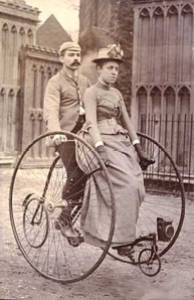“Let me tell you what I think of bicycling. I think it has done more to emancipate women than anything else in the world. I stand and rejoice every time I see a woman ride by on a wheel.”
Susan B. Anthony, 1896
 For a little fun today, let’s look at something simple that made a big impact of the freedom of women – the bicycle! By the 1890s, bicycling had become very popular in the United States as well as in Europe, and women weren’t going to be left out of the fun. Bicycles allowed women more freedom of movement out of their own neighborhoods and into the world at large. They could go farther in less time and it was much cheaper to maintain than a horse!
For a little fun today, let’s look at something simple that made a big impact of the freedom of women – the bicycle! By the 1890s, bicycling had become very popular in the United States as well as in Europe, and women weren’t going to be left out of the fun. Bicycles allowed women more freedom of movement out of their own neighborhoods and into the world at large. They could go farther in less time and it was much cheaper to maintain than a horse!
Susan B. Anthony said in an interview with the New York World in 1896, that the bicycle “has done more to emancipate women than anything else in the world.” Francis Willard, president of the Women’s Christian Temperance Union, even wrote a book about how she learned to ride a bicycle later in life.
But, for a woman to be truly comfortable on a bicycle, not to mention safe, their clothing needed to be modified. In the 1970s when bell-bottoms became popular, we used to put rubber bands around our ankles to keep our pants legs from getting tangled up in the gears. I can’t imagine trying to ride with long skirts.
“Her miserable style of dress is a consequence of her present vassalage not its cause. Woman must become ennobled, in the quality of her being. When she is so, . . . she will be able, unquestioned, to dictate the style of her dress.” Lucy Stone
So in the 1890s, “Bloomers”, or Turkish trousers, which had come and gone from fashion in the 1850s, made a comeback. This was an outfit that included full trousers gathered at the ankle with a short dress over them. (Although not developed by Amelia Bloomer, she advocated them in her magazine The Lily.)
 Around the same time there was a movement toward more rational dress for women, due in part to the unhealthy nature (not to mention extreme discomfort) of corsets. Bloomers were soon displaced by an even more “radical” getup – rationals.
Around the same time there was a movement toward more rational dress for women, due in part to the unhealthy nature (not to mention extreme discomfort) of corsets. Bloomers were soon displaced by an even more “radical” getup – rationals.
“Woman will never hold her true position, until, by a firm muscle and a steady nerve, she can maintain the RIGHTS she claims . . . but she cannot make the first move . . . until she casts away her swaddling clothes.” Elizabeth Cady Stanton
Were increased freedom of women on bicycles and the corresponding change in dress in part responsible for a move toward women’s liberation, or were they the result of it? It’s an interesting question, but there will always be those who, even when they accept a new found freedom will try to control it. Women were cautioned not to develop the “bicycle face” and warned that their vocal chords were changing because of bicycle riding, making women loud talkers with harsh voices. Check out this long list of don’t’s for women cyclists at Brainpickings.org, including such things as the following:
“Don’t chew gum. Exercise your jaws in private.”
“Don’t try to ride in your brother’s clothes ‘to see how it feels.’”
“Don’t scream if you meet a cow. If she sees you first, she will run.”
Sigh. . . Enjoy your freedom ladies. It was hard fought for and not every woman in the world has the same freedoms today. The fight isn’t over!






